


Jatropha Feasibility Study Results (2008-2010)
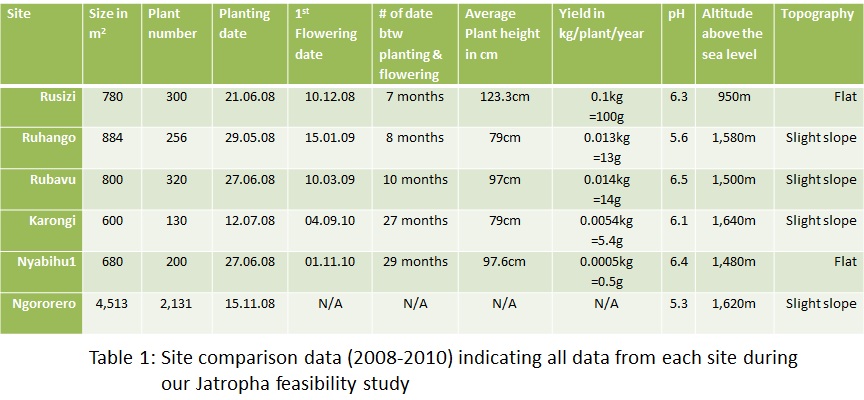
This document is the summary of the Jatropha feasibility study conducted in Rwanda between 2008 and 2010.
Jatropha Carcus is a tree native in the American continent but was introduced to Africa during the colonial period. The tree is very strong against dryness and it can even survive under drought by intentionally dropping its leaves. Also, the tree is recognized as poisonous and some people were using it to keep domestic animals away from the predators. Thus, two primary intentions of the original introduction to Africa were for anti-deforestation and as a fence tree.
Recently, Jatropha is in a way booming due to another aspect. The seeds contain about 40% of oil and the extracted crude oil can be used for cooking heat and lighting (some are already producing soaps from the oil). Moreover, after the refinery, the oil can be utilized as bio-diesel. Considering its features of dryness resistance and non-edibleness, Jatropha has a potential to be planted at non-arable areas and at the rim of crop fields and to produce a new energy source and income generating opportunity.
However, there is no reliable data available on the adaptability and productivity of Jatropha in Rwanda. As a highly populated and relatively water-rich country, a typical way of planting Jatropha for bio-diesel production where the trees are exclusively planted at a huge dry plantation does not fit in Rwanda. Additionally, risks of ecological damage caused by planting Jatropha in Rwanda must be investigated as well as its financial robustness. This is why we have conducted a small scale study and tried to collect basic data to find out whether Jatropha project is feasible in Rwanda.
As indicated in the table above, data were collected for plot (site) sizes, a number of Jatropha plants per site, the average Jatropha plant heights, the average Jatropha yield per site, etc.
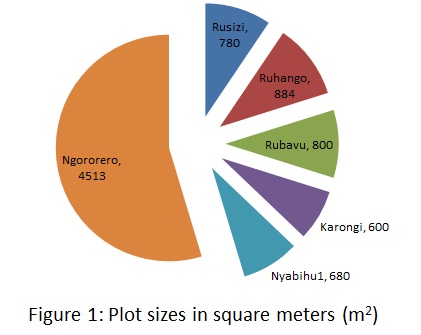 The figure above illustrates clearly that Ngororero site located in the western province has the biggest plot size totaling to 4513 meter squared (m2), which is equivalent to 55% of the total land used at all sites during this phase. The second is Ruhango with 884m2 plot size, and the third is Rubavu with the plot size equivalent to 800m2.
Rusizi plot is the fourth one with 780m2, followed by Nyabihu1 and Karongi with 680m2 and 600m2 plot sizes in meter squares respectively.
The figure above illustrates clearly that Ngororero site located in the western province has the biggest plot size totaling to 4513 meter squared (m2), which is equivalent to 55% of the total land used at all sites during this phase. The second is Ruhango with 884m2 plot size, and the third is Rubavu with the plot size equivalent to 800m2.
Rusizi plot is the fourth one with 780m2, followed by Nyabihu1 and Karongi with 680m2 and 600m2 plot sizes in meter squares respectively.
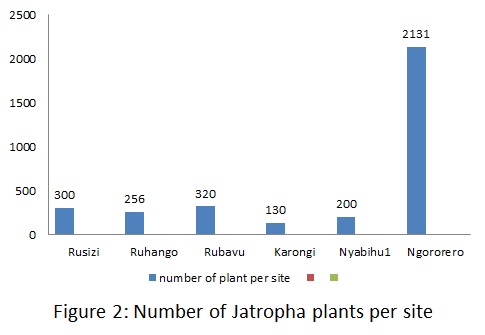
As the above graph shows, during our feasibility study, Ngororero site had 2131 Jatropha plants. Rubavu ranked the second position with 320 Jatropha plants and the third was Rusizi with 300 Jatropha plants, followed by Ruhango ranking the fourth whereby Nyabihu1 and Karongi were the last two sites to bear a small number of Jatropha plants during this study. The standard spacing of 2m x 2m of Jatropha planting was not respected at Rusizi site and just 1m x 1m spacing was introduced instead of 2m x 2m.
The change in spacing did not affect Jatropha as well as intercrops practiced there like soybeans and watermelons in two different seasons. Rather, the yield of watermelons, for example, was seriously disturbed by people who invaded our site and damaged the young growing watermelons, some being cut and thrown into Rusizi running river along the site. When we asked local people around the reason why they cut immature melons, they answered that some were very curious about contents of watermelons since it was their first time to see such plants growing in the area.
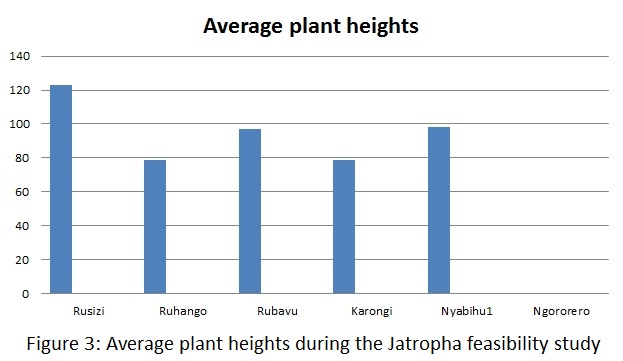
The growth was measured during the feasibility from its transplanting until flowering and harvesting time. Results show that Rusizi was the best in quick growing in terms of height since the average plant height is more than 120cm tall. At Nyabihu1 and Rubavu sites, the growth of Jatropha plants was almost uniform as the figures above indicate that the average Jatropha heights were 98cm and 97cm respectively. In Ruhango and Karongi, the growth was almost uniform as the figures illustrate that the average heights were both 79cm tall.
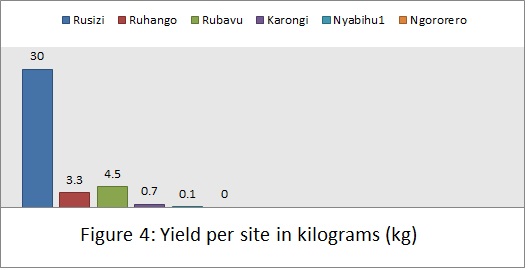
Yield was determined after taking off all the husks and by drying the seeds and weighing them by using an electronic balance. The results show that Rusizi total harvest is 30kg, which is significantly different from the yields of other sites. Rubavu had the second biggest yield of Jatropha seeds with 4.5kg in total, while Ruhango was the third with 3.3kg. Yields in Karongi and Nyabihu1 were very poor where the total yields did not even exceed one kilogram per site. At Ngororero site, there was no harvest until now except for some non-measurable amount of seeds harvested at an abandoned part of the site. However, there is a hope of harvesting in Ngororero since some Jatropha plants that have been recently replanted are showing positive signs by flowering. So, there is still a possibility that sometime soon we might be able to expect big harvest from this site (or even the biggest among all the feasibility sites).
However, in order to realize such big harvest expected at Ngororero site, soil conditions need to be improved seriously either by using organic manure or chemical fertilizer. Otherwise, the soil is too infertile. Seemingly, its fertility was consumed by eucalyptus that was planted there about 7 decades back. For the case of recent Jatropha shrubs replanted, they were treated with some organic manure that we manufactured via composting by ourselves. Additionally, some fertilizers from a local agricultural company, the ‘Organic Solutions’, also helped a big part of the site and made Jatropha growing vigorously. To boost the yield or to attain good yield, such efforts have to be underlined.
Based on the above analyses, we can conclude that following elements are critical to influence the Jatropha seeds yield in Rwanda:
1. Altitude/Temperature:
Rusizi site (more specifically, Bugarama sector) is situated in the lowest part of Rwanda of 950m above the sea level, which contributed significantly to high yield of Jatropha. This means that Jatropha is not favorable to cold weather at a high altitude. For example, Jatropha at Nyabihu2 site could not grow and just wilted as the site altitude was about 2,300m above the sea level and the climate there was too cold for Jatropha. We gave up Jatropha production at Nyabihu2 site and are now trying to grow apples.
2. Heavy rains:
Jatropha seems to prefer dryness. Jatropha growth is slow in Rwanda as it enjoys the typical tropical weather and we have high precipitation during rainy seasons.
3. Topography:
Originally, it was expected that Jatropha could play a role to prevent severe soil erosions in Rwanda. But it has turned out that it is very weak against landslides especially when they are baby trees as their roots grow mainly vertically (cf. bamboos are well known to effectively stop soil erosions and the roots grow mainly horizontally). This is why Jatropha trees in Rutsiro site, where the site was very steep, were mostly washed away by landslides caused by heavy rains. At Rutsiro site, a quick decision was made to give up the site since no Jatropha could exist due to the slope nature.
4. Soil fertility:
Bugarama site in Rusizi has a very good soil condition with high carbon contents. This is a very good factor when we seek high yields of any plants as well as Jatropha. Originally, we were told that Jatropha could grow anywhere even with little cultural technics, but we have learned that it is not true in Rwanda. If you plant Jatropha with aim of high yield performance, it will need all technical/cultural operations such as weeding, fertilizing, pruning, and spraying for pests if applicable. Otherwise, you will run short of yield. This experience is shared with our counterpart Jatropha researcher in Arusha, Tanzania during our four-day study trip to Jatropha plantations in different districts like Siha and others there.
Note: During our feasibility study, one site was identified in Kagano Sector in Nyamasheke District. But as the soil there was very poor, our planted Jatropha did not show any growth instead dying prematurely. Thus, we decided to apply a small amount of chemical fertilizers on some Jatropha plants as an experiment. We noticed positive growth changes, but we could not continue to use chemical fertilizers since our objective was not to use any fertilizer. After one year of transplanting Jatropha to the site, Kagano site became abandoned as we could not see any growth sign or harvest.
Concerning utilization of crude oil from Jatropha seeds as an energy source, it depends on yield quantity, where more than 3kg of Jatropha seeds are reported to be necessary to produce 1litre of crude oil. Referring to the research results, even though Rusizi yield made significant difference in yield performance compared to other sites during our feasibility study, it (i.e. 0.1kg/plant/year) was still far below from ideal yield of 2-3kg per plant per year. Based on the current result, it is difficult to produce any crude oil. However, it seems that the low yield was also caused by additional factors to those mentioned above, such as delayed harvest and immature picking by kids who used to invade the field.
Of course, Jatropha yield could increase depending of its growing years. But the growth rate would be influenced by many factors like weeding rates, pruning, soil condition, rainfall patterns, and the average temperature per annum. Therefore, our original intention of using the Jatropha crude oil as replacement of firewood would be only potential when all the above conditions are satisfied, which is, we have learned after conducing this study in ten-district sites in Rwanda, quite challenging.
Conclusion and recommendation
We recommend strongly, to anyone willing to grow Jatropha in Rwanda, to consider and introduce all cultural technics that are necessary for any other crops or research plants in order to expect good harvest. Additionally, the above stated elements/conditions necessary for high yield of Jatropha must be considered.

 The figure above illustrates clearly that Ngororero site located in the western province has the biggest plot size totaling to 4513 meter squared (m2), which is equivalent to 55% of the total land used at all sites during this phase. The second is Ruhango with 884m2 plot size, and the third is Rubavu with the plot size equivalent to 800m2.
Rusizi plot is the fourth one with 780m2, followed by Nyabihu1 and Karongi with 680m2 and 600m2 plot sizes in meter squares respectively.
The figure above illustrates clearly that Ngororero site located in the western province has the biggest plot size totaling to 4513 meter squared (m2), which is equivalent to 55% of the total land used at all sites during this phase. The second is Ruhango with 884m2 plot size, and the third is Rubavu with the plot size equivalent to 800m2.
Rusizi plot is the fourth one with 780m2, followed by Nyabihu1 and Karongi with 680m2 and 600m2 plot sizes in meter squares respectively.






